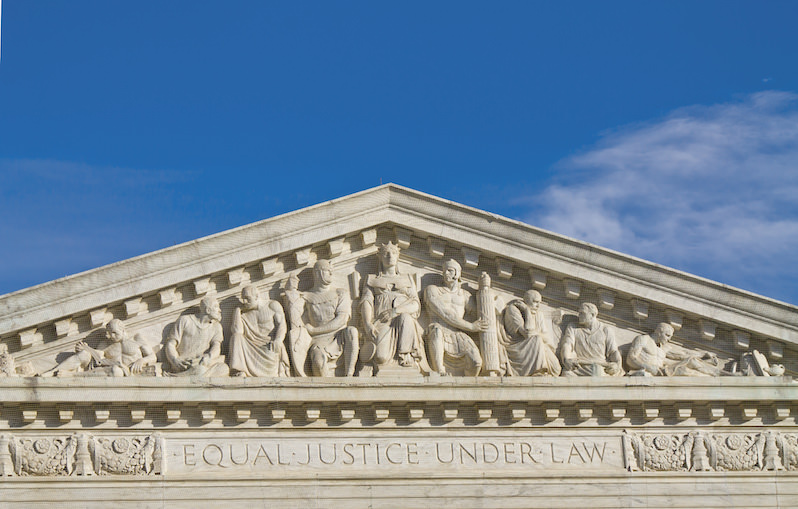Supreme Court Moves to Undo Civil Rights Law … Again
The U.S. Supreme Court has once again taken it upon itself to reconsider a landmark civil rights law. Shutterstock
Shutterstock
The U.S. Supreme Court has once again taken it upon itself to reconsider a landmark civil rights law. Under the Fair Housing Act of 1968 and subsequent legal precedents, individuals or institutions can be sued for racial segregation in housing even if they cannot prove that the segregation was intentional. But conservatives have long argued that segregation ought to be legal as long as it is not deliberate. Now, the court, under Chief Justice John Roberts, also seems to want to see it that way.
The case in question was brought by a nonprofit organization in Texas called the Inclusive Communities Project, which found that state-funded vouchers for affordable housing were being issued almost exclusively in black neighborhoods, ensuring that white suburbs were spared the presence of low-income residents. So ICP sued the Texas Department of Housing and Community Affairs saying it was a violation of the Fair Housing Act. Enter the Supreme Court.
It is clear that some justices feel that a reconsideration of the historic law is in order. Two earlier housing cases that the court wanted to take on were settled by lower courts. The Texas case is the third one in three years in which the court has expressed interest. In January, the court heard oral arguments, and while Justice Antonin Scalia, a stalwart conservative, appeared to ask some tough questions last week of the attorney representing Texas, the final ruling is still up in the air. A 5-4 vote in favor of Texas could end up devastating a law that has been in place for more than 40 years.
It should not surprise us that some justices want to end fair housing. In 2013, the Supreme Court eviscerated a key provision of the 1965 Voting Rights Act, allowing states to change their voting requirements without having to consult with the federal government. That ruling undermined a protection that had been hard-won by the civil rights movement. Immediately after the 2013 ruling, a number of states jumped at the chance to create obstacles to voting, particularly for poor people of color. The documented impact of the ruling on the November 2014 elections was found to be significant.
Housing discrimination has historically formed the basis of racial segregation in the United States, and sharp disparities still exist along color lines. The language of the Fair Housing Act is simple. It “prohibits discrimination in the sale, rental, and financing of dwellings, and in other housing-related transactions, based on race, color, national origin, religion, sex, familial status … and disability.” What the Supreme Court is considering is whether that language can be used to sue on the basis of “disparate impact,” rather than actual intent. In other words, if the result of an institution’s actions appears racist, that does not mean it is racist.
The U.S. has an ugly history of making such fallacious distinctions. In the 1960s, Southern states often administered complicated and confusing “literacy tests” to African-Americans who wanted to register to vote. The tests were designed for failure and enabled Southern officials to claim they were following the letter of the law because as long as blacks passed the test they were allowed to register. It didn’t matter if almost no one could pass the tests. It didn’t matter if there was a racist outcome as long as there was no proof of racist intention. But how does one prove a racist intention?
John A. Powell is a professor of law, African American studies, and ethnic studies, the Robert D. Haas Chancellor’s Chair in Equity and Inclusion, and the director of the Haas Institute for a Fair and Inclusive Society at UC Berkeley. His latest book is titled “Racing to Justice: Transforming Our Concepts of Self and Other to Build an Inclusive Society.” He also sits on the board of directors of the Inclusive Communities Project. In an interview Tuesday on “Uprising,” he told me that for the court “to suggest that a body of law that has been in place since the 1960s under fair housing is inappropriate, is really saying, ‘Let’s go back; let’s return to the good old days where we allow discrimination. …We allow a society that’s highly regulated by race, as long as we can’t prove intent.’ “
Powell cited the example of climate change: “How many people say, ‘I’m getting up today and I’m going to deliberately try to warm the planet?’ Whether we are trying to make the climate change … is almost irrelevant. The question is, are we?”
Incidentally, under the current law, if an institution being sued under the Fair Housing Act can prove there is a good reason for disparate impact, it is not held accountable. For example, if a bank is shown to be offering higher cost loans to African-Americans and claims that such a pattern exists because African-Americans have lower credit scores, the existing law protects the bank (even if it shouldn’t). In fact the Fair Housing Act, as it is written, does not go far enough, given the ongoing racial segregation in housing nationwide. And still the Supreme Court is considering gutting this modest protection. According to Powell, the current configuration of the U.S. Supreme Court seems to espouse an agenda to “curtail civil rights and expand corporate rights.” In fact, there seems to be a strong pattern of expanding the definition of what corporations are entitled to, including treating them as persons, which, as Powell pointed out, is not in the Constitution. At the same time, the court has been narrowing the definition of civil rights. “The court is on a very disturbing trend,” Powell said, “to try to turn back the clock to the early 1950s.”
The hubris of this court is astonishing. The Fair Housing Act was passed in 1968 by Congress and signed into law by President Lyndon B. Johnson. It was then expanded in 1988 under Republican President Ronald Reagan to include discrimination against people based on disability or familial status. The law has been used hundreds of times to undermine discrimination in housing. Why, then, should the court take it up? Liberal Justice Stephen Breyer asked the same question during the Fair Housing Act case last week: “Why should this court suddenly come in and reverse an important law which seems to have worked out in a way that is helpful to many people, [and] has not produced disaster?”
The judiciary is supposed to interpret law, not make it. Lawmaking is the job of Congress and the president. And yet, as the 2010 ruling in Citizens United v. FEC showed, the court can do away with laws put into place by democratically elected lawmakers simply because it wants to. In the Citizens United case — which is a classic example of the expansion of corporate rights that Powell referred to — the Supreme Court chose to intervene even though it was not asked to, just as it is doing in the case over fair housing.
If fair housing is decimated, the repercussions on other aspects of American society could be widely felt. For example, the already racially segregated public school system is likely to become even more divided. Kids go to school where they live, and if housing discrimination runs rampant, so will educational apartheid.
The maxim that conservatives often employ to celebrate war veterans — “they died for our freedoms” — literally holds true for the civil rights movement. Scores of Americans, black and white, struggled, risked their lives and died so we could have a set of laws that protect us from the worst aspects of institutional racism. The Supreme Court, in taking up the Fair Housing Act of 1968, is once again denigrating the memory of the civil rights movement and thumbing its nose at the brave warriors who fought with blood and tears for racial equality.
Your support matters…Independent journalism is under threat and overshadowed by heavily funded mainstream media.
You can help level the playing field. Become a member.
Your tax-deductible contribution keeps us digging beneath the headlines to give you thought-provoking, investigative reporting and analysis that unearths what's really happening- without compromise.
Give today to support our courageous, independent journalists.






You need to be a supporter to comment.
There are currently no responses to this article.
Be the first to respond.